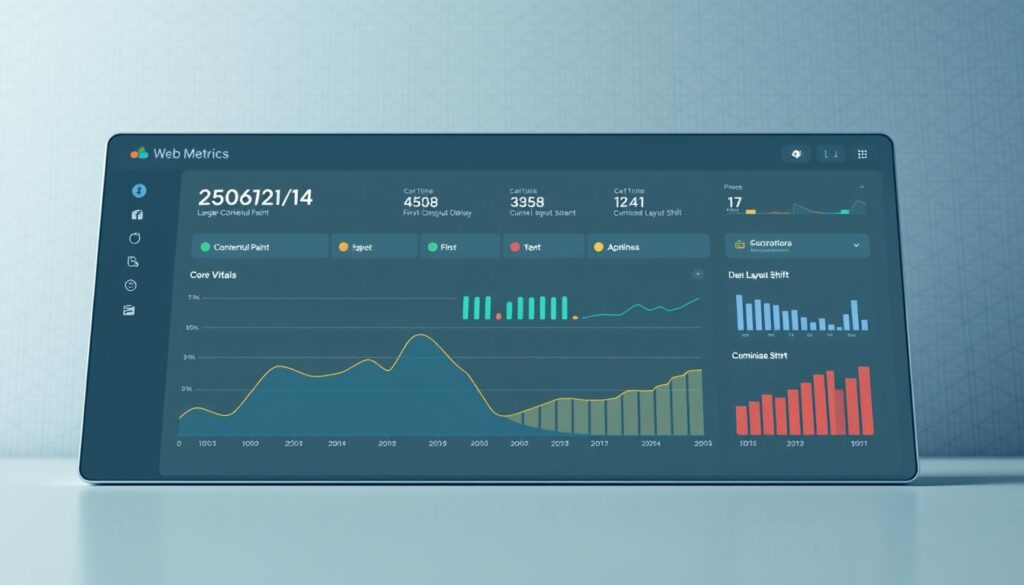In today’s digital world, knowing how to handle Core Web Vitals is key. These metrics, set by Google, focus on page speed, how fast your site loads, and how stable it looks. They play a big role in how users feel when they visit your site.
By improving these areas, you can boost your site’s ranking on search engines. This leads to more people visiting and staying on your site, which can increase sales. We’ll look into why Core Web Vitals matter, what they measure, and how to make your site better.
Table of Contents
Key Takeaways
- Core Web Vitals are vital for improving user experience and SEO success.
- Key metrics include page speed, responsiveness, and visual stability.
- Optimisation strategies can lead to increased user engagement.
- Google prioritises websites that perform well in Core Web Vitals.
- Higher rankings can translate to improved conversion rates.
- Regular monitoring of these metrics is essential for ongoing optimisation.
What Are Core Web Vitals?
Understanding core web vitals is key for better website performance. These metrics show how users feel about your site. Google created them to check three main things: how fast your site loads, how well it works, and how stable it looks.
These aspects are vital for a good user experience. They help make your site easier to use and improve its ranking on search engines.
Definition and Purpose
Core web vitals measure how real users interact with your website. They look at how fast your site loads, how well it responds, and if it looks stable while browsing. This helps you understand how users experience your site.
By improving these areas, you can keep visitors longer and reduce bounce rates. Making your site better aligns with these standards helps create a better user experience.
Importance of User Experience Metrics
User experience metrics give you insights into your website’s success. By looking at core web vitals, you find what needs work. This leads to a better site and happier users.
Fast-loading sites keep visitors interested. So, improving core web vitals is key for keeping customers and building trust. It also helps with conversions.
Understanding the Core Web Vitals Metrics
Core Web Vitals focus on key website metrics that affect user experience. Understanding metrics like Largest Contentful Paint (LCP), First Input Delay (FID), and Cumulative Layout Shift (CLS) helps assess and improve website performance. Each metric offers insights into loading, interactivity, and visual stability.
Largest Contentful Paint (LCP)
Largest Contentful Paint (LCP) measures loading performance. It looks at the time it takes for the largest content element to load. This could be an image or text. A good LCP score is under 2.5 seconds.
Improving LCP boosts user engagement. Faster load times make a better first impression. For tips on improving LCP, visit here.
First Input Delay (FID)
First Input Delay (FID) tracks the time from a user’s first action to the browser’s response. Aim for an FID score under 100 milliseconds. Long delays can lead to user frustration and lower engagement.
To improve FID, focus on optimising JavaScript and ensuring quick responses to user inputs.
Cumulative Layout Shift (CLS)
Cumulative Layout Shift (CLS) evaluates visual stability during page loading. It measures content shifts that might disorient users. Aim for a CLS score under 0.1.
Keeping content stable is key to user satisfaction. Avoiding content shifts can prevent user frustration. Focus on stable layouts and define sizes for images and ads to improve CLS.
Core Web Vitals and Their Impact on SEO
Core Web Vitals are key to your website’s SEO success. Google now uses these metrics in its ranking system. Websites that improve their LCP, FID, and CLS will likely rank higher on Google.
These metrics are vital because they directly affect how users interact with your site. A good user experience means more engagement and better SEO.
Google’s Ranking Algorithm
Google’s algorithm now values Core Web Vitals highly. A site that excels in LCP, FID, and CLS will be more visible in search results. This makes your site look more professional.
Such improvements can lead to more organic traffic. This boosts your SEO performance and shows the value of focusing on user needs.
User Engagement and Bounce Rates
A fast, responsive, and stable site keeps users interested. This means they’re more likely to stay and explore. Lower bounce rates tell Google your site is good.
High engagement rates show search engines your site is valuable. This helps your ranking on Google. By focusing on Core Web Vitals, you improve user experience and meet search engine goals.
Why Core Web Vitals Matter for User Experience
Core Web Vitals play a big role in how users feel about a website. They affect how long users stay and how likely they are to make a purchase. A fast and smooth website makes users happy, encouraging them to stay and explore more.
User Retention and Conversion Rates
Websites that do well in Core Web Vitals keep users coming back. A responsive and engaging site builds loyalty. This loyalty can lead to more sales or newsletter sign-ups. By focusing on these areas, you can stand out and build a loyal customer base.
The Role of Performance in User Satisfaction
How well a website performs greatly affects user happiness. A smooth experience lets users move around easily, making their visit better. Happy users spend more time on your site, which helps keep them coming back and boosts sales.
Strategies for Optimising Core Web Vitals
Boosting Core Web Vitals improves user experience and SEO. Using the right strategies for each metric makes your site better for users and search engines.
Improving LCP Through Image Optimisation
Optimising Largest Contentful Paint (LCP) starts with image optimisation. Smaller images and formats like WebP speed up loading. Make sure images are the right size and well-compressed for fast display.
Enhancing FID by Minimising JavaScript
First Input Delay (FID) shows how fast users can interact with your site. To improve FID, cut down on JavaScript. Use less heavy scripts and delay non-essential JavaScript. This makes your site more responsive and user-friendly.
Reducing CLS for Visual Stability
Keeping your site visually stable is key for better Cumulative Layout Shift (CLS). Use specific sizes for images and avoid layout shifts during loading. These steps make your site more reliable and keep visitors longer. Regular SEO checks help; see this essential guide for more.
Tools for Measuring Core Web Vitals
Getting the right measurements for Core Web Vitals is key to better website performance. Many tools give insights into how your site does. They help you make smart choices to improve it.
Google PageSpeed Insights
Google PageSpeed Insights is a top choice for checking webpage performance. It looks at how your site works on different devices. It also checks how fast it loads and how users feel when using it.
This tool gives detailed reports. It shows where your site does well and where it needs work. It offers tips to boost your Core Web Vitals scores.
Lighthouse for Detailed Analysis
Lighthouse is a powerful tool that looks at more than just speed. It’s open-source and checks site performance, usability, and SEO. With Lighthouse, you get a full picture of your site’s performance against industry standards.
This helps you spot areas for improvement. It’s a great way to make your site better.
Using Chrome DevTools
Chrome DevTools is perfect for developers who want to check performance live. It lets you see and fix your website as you go. With Chrome DevTools, you can do performance audits and make your site run smoothly.
This hands-on way of checking Core Web Vitals can really help improve your site.
Common Mistakes When Addressing Core Web Vitals
Many website owners face common mistakes when improving Core Web Vitals. These errors often come from not knowing key factors that affect user experience and site efficiency.
Ignoring Mobile Responsiveness
Ignoring mobile responsiveness is a big mistake. Over 50% of web traffic comes from mobile devices. If your site doesn’t load well on phones, you’ll lose customers.
It’s vital to make your site mobile-friendly. This ensures it meets user expectations and keeps visitors engaged.
Overlooking Third-Party Scripts
Another common mistake is overlooking third-party scripts. These scripts add functionality but can slow down your site if not managed well. It’s important to review and cut down on unnecessary scripts.
Managing scripts properly can improve your site’s performance. This leads to happier users and better retention.
By fixing these mistakes, you can greatly enhance your site’s Core Web Vitals. Regularly check and improve your site’s performance and user experience. For more tips, check out mobile optimisation tips for successful web management.
Case Studies Demonstrating Core Web Vitals Success
Many case studies show the big wins from improving Core Web Vitals. They show how better web performance leads to better business results. These examples show how companies have made their websites faster and more user-friendly, leading to real gains.
Real-World Examples of Improvement
Vodafone in Italy saw a 31% better LCP, which boosted sales by 8%. Tokopedia’s work on LCP led to a 55% improvement, increasing session time by 23%. Cdiscount worked on all three Core Web Vitals and saw a 6% revenue jump during Black Friday.
These stories prove that improving Core Web Vitals makes websites better for users and boosts sales. For more on these successes, check out the business impact case studies online.
The Business Impact of Core Web Vitals Optimisation
Every case study shows the big business benefits of improving Core Web Vitals. Tencent Video’s click-through rate for videos went up by 70% after improving Core Web Vitals. Redbus saw mobile conversion rates of 80-100%, showing the power of web performance.
Nykaa’s 40% better LCP brought 28% more organic traffic from smaller cities. AliExpress’s work on CLS and LCP cut bounce rates by 15%. These stories prove that investing in Core Web Vitals is a smart move for businesses of all sizes.
Future Trends in Core Web Vitals
The world of Core Web Vitals is changing fast. This is due to new user needs and tech breakthroughs. It’s key to understand how these changes affect how websites work and feel.
Adapting to Changing User Expectations
User wants are changing quickly. People now want websites to load fast and work smoothly. They don’t have time for slow or clunky sites.
To meet these new needs, your website might need updates and new features. This keeps it fast and user-friendly.
Technological Advancements Affecting Web Performance
New tech is a big part of the future. Tools and frameworks are being made to make websites better. For example, progressive web applications (PWAs) make sites work offline and load quickly.
By using these new tools, you can keep up with performance standards. This also helps you keep users happy and engaged.
Conclusion
Mastering Core Web Vitals is key for SEO success and better user experience. As the digital world changes, focusing on Largest Contentful Paint (LCP), First Input Delay (FID), and Cumulative Layout Shift (CLS) is important. These metrics affect your site’s performance and how it ranks on search engines.
Using tools like Google PageSpeed Insights to check your site’s performance is a good idea. This helps you find areas to improve. By working on your core web vitals, you can see better user engagement and higher conversion rates. These are important for your site’s success in a competitive market.
Improving these key metrics helps your site grow and stay visible online. For more on how core web vitals impact SEO, check out this essential guide.
FAQ
What are Core Web Vitals?
Core Web Vitals are important user experience metrics used by Google. They check how fast a webpage loads, how interactive it is, and how stable it looks. This includes Largest Contentful Paint (LCP), First Input Delay (FID), and Cumulative Layout Shift (CLS).
How do Core Web Vitals affect my website’s SEO?
Core Web Vitals greatly affect SEO. Google uses these metrics to rank websites. Websites that do well in LCP, FID, and CLS get better search rankings. This can lead to more engagement and fewer people leaving your site quickly.
What is the optimal score for LCP, FID, and CLS?
The best scores are: LCP should be 2.5 seconds or less. FID should be under 100 milliseconds. CLS should be less than 0.1 for a good user experience.
How can I improve my LCP score?
To better your LCP score, optimise images. Compress them and use formats like WebP. This makes your site load faster and perform better.
What common mistakes should I avoid when optimising Core Web Vitals?
Avoid ignoring mobile responsiveness. Most web traffic comes from mobiles. Also, don’t overlook third-party scripts, as they can slow down your site.
What tools can I use to measure my Core Web Vitals?
Use tools like Google PageSpeed Insights for detailed reports. Lighthouse offers a full analysis. Chrome DevTools help with real-time checks and debugging.
Are there any real-world examples of Core Web Vitals optimisations leading to success?
Yes, many case studies show success. For example, a news site improved its LCP for mobiles. It saw a 20% increase in session time and a 10% rise in conversions.
What future trends should I be aware of regarding Core Web Vitals?
Future trends include more focus on mobile performance and responsive design. As mobile use grows, new optimisation techniques will emerge to improve performance.









